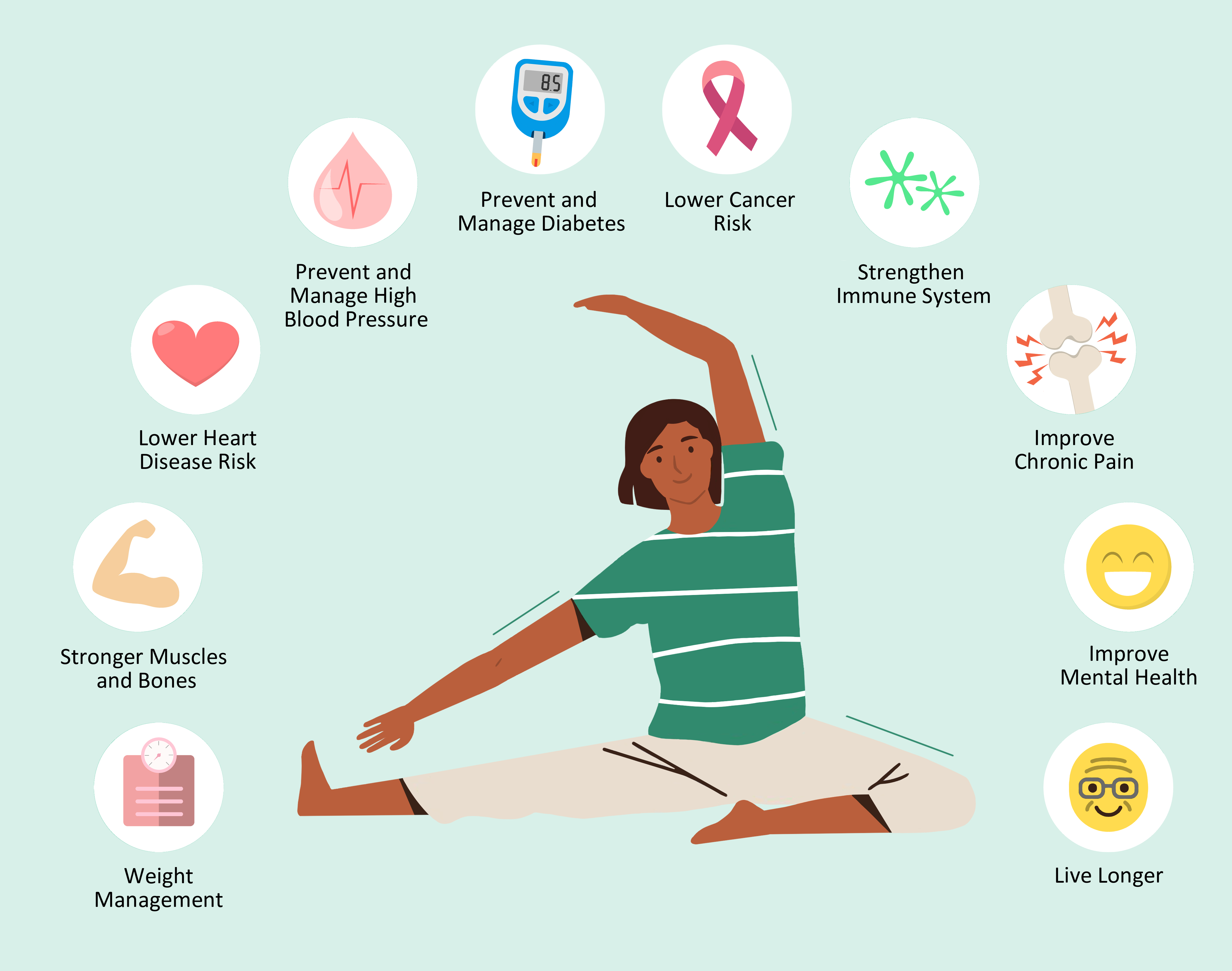The 2018 Physical Activity Guidelines Advisory Committee, as part of the United States Department of Health and Human Services, recommends 500 to 1000 metabolic equivalent (MET)-minutes (150 to 300 minutes) per week of moderate-intensity physical activity.1 This recommendation remains unchanged from the most recently published 2008 Physical Activity Guidelines for Americans.2 One MET is the rate of energy expended when sitting at rest, or approximately equivalent to an oxygen uptake of 3.5 ml/kg/min.1 Moderate-intensity activity is defined as activity that requires 3.0 to 6.0 METs, such as walking briskly or mopping, while light-intensity activity requires 1.6 to 3.0 METs, such as walking slowly or cooking. Vigorous activity such as tennis, bicycling, soccer, jogging, and tennis may require more than 6.0 METs.
Based on multiple studies, these guidelines note that there is an inverse dose-response association between exercise and all-cause mortality.1 Moore et al. examined the relationship between leisure time physical activity and all-cause mortality in a pooled analysis from six prospective cohort studies (n=654 827) in the National Cancer Institute Cohort Consortium, with individuals aged 21 to 90 years.3 Subjects were stratified based on MET-hours/week (MET-h/wk). As physical activity levels increased, life expectancy also increased. Compared to no leisure time activity, an activity level of 0.1 to 3.74 MET-h/wk was associated with a gain of 1.8 years (95% confidence interval [CI] [1.6 – 2.0]) in life expectancy. At the highest level of physical activity (more than 22.5 MET-h/wk), there was an associated gain of 4.5 years (CI [4.3 – 4.7]).
Exercise is associated with a decreased risk of cardiovascular disease, such as coronary heart disease, stroke, and heart failure.1 In a 2013 meta-analysis using 43 studies for ischemic heart disease and 26 for ischemic stroke, Kyu et al. found that more than 8000 MET-minutes/week was associated with a decreased risk of 25% (relative risk [RR] 0.754, CI [0.704 – 0.809]) for heart disease and 26% (RR 0.736, CI [0.659 – 0.811]) for stroke.4 In a 10-year prospective cohort study (n=4289, mean age 49.2) examining inflammatory markers and physical activity, participants who adhered to physical activity guidelines had lower loge C-reactive protein (beta=-0.07, CI [-0.12 – -0.02]) compared to participants who were inactive.5 The American College of Cardiology and American Heart Association have also included aerobic physical activity in their recommendations as part of a strategy to reduce cardiovascular risk by reducing low-density lipoprotein cholesterol, non- high-density lipoprotein cholesterol, and blood pressure.6 They note that their findings are consistent with the 2008 Physical Activity Guidelines for Americans.
Exercise is associated with a decreased risk of developing bladder, breast, colon, endometrial, esophageal, gastric, and renal cancers.1 Kyu et al. also found that more than 8000 MET-minutes/week was associated with a decreased risk of 14% (RR 0.863, CI [0.829 – 0.900]) for breast cancer and 21% (RR 0.789, CI [0.735 – 0.850]) for colon cancer.3
In terms of diabetes, the same study found a decreased risk of 28% (RR 0.722, CI [0.678 – 0.768)) for diabetes.3 There was an exercise dose-response pattern: a 600 MET-minutes/week was associated with a decreased risk of 2% for diabetes, while a 3600 MET-minutes/week reduced the risk of diabetes further by 19%. The 2018 Physical Activity Guidelines Advisory Committee did not examine the effects of physical activity on the risk of developing type 2 diabetes, but it did find an inverse association between physical activity and the risk of progression in individuals with type 2 diabetes as measured by glycated hemoglobin A1C level, blood pressure, body mass index, and lipids.1
Exercise can also improve symptoms of anxiety and reduce the risk of depression.1 A 2015 meta-analysis of 36 randomized control trials (n=1233) found that acute bouts of exercise lasting 20 to 30 minutes significantly reduced anxiety symptoms when compared with no exercise (Hedges’ g=0.16), as measured by the State Anxiety Inventory.7 A 2018 meta-analysis of 49 prospective cohort studies found that people who had high levels of physical activity had lower odds of developing depression (odds ratio [OR] 0.83, CI [0.79 – 0.88)) when compared to those who had lower levels of activity.8
Exercise is associated with decreased level of pain in people with osteoarthritis (OA), and some studies show that OA of the knee is not accelerated when walking up to 10 000 steps per day.1 A meta-analysis9 of 13 randomized controlled trials (n =1190) of patients with OA in aquatic exercise compared to control groups found that the exercise groups had improvement in pain scores (standardized mean difference [SMD] =-0.32, CI [-0.47 – -0.17]). Another meta-analysis10 of nine randomized controlled trials comparing diet-only treatments and combined diet and exercise treatments in patients with OA also found that the combined treatment was associated with moderately reduced pain (SMD=-0.37, CI [-0.69 – -0.04]) while the diet-only treatments were not (SMD=-0.13, CI [-0.37 – 0.10]). The 2018 Physical Activity Guidelines Committee conducted its own systematic review regarding physical activity and OA disease progression, and included five longitudinal cohort studies which all included MRI imaging of the knee.1 The committee concluded that benefits, such as pain relief, are seen in patients with RA at step counts up to 10 000 per day, while more steps were associated with OA disease progression.1,11
References
- 2018 physical activity guidelines advisory committee scientific report. Washington, D.C.: U.S. Department of Health and Human Services;2018.
- 2008 physical activity guidelines for americans. Washington, D.C.: U.S. Department of Health and Human Services;2008.
- Moore SC, Patel AV, Matthews CE, et al. Leisure time physical activity of moderate to vigorous intensity and mortality: A large pooled cohort analysis. PLoS Med. 2012;9(11):e1001335.
- Kyu HH, Bachman VF, Alexander LT, et al. Physical activity and risk of breast cancer, colon cancer, diabetes, ischemic heart disease, and ischemic stroke events: Systematic review and dose-response meta-analysis for the global burden of disease study 2013. BMJ. 2016;354:i3857.
- Hamer M, Sabia S, Batty GD, et al. Physical activity and inflammatory markers over 10 years follow up in men and women from the whitehall ii cohort study. Circulation. 2012;126(8):928-933.
- Eckel RH, Jakicic JM, Ard JD, et al. 2013 aha/acc guideline on lifestyle management to reduce cardiovascular risk: A report of the american college of cardiology/american heart association task force on practice guidelines. Circulation. 2014;129(25 Suppl 2):S76-99.
- Ensari I, Greenlee TA, Motl RW, Petruzzello SJ. Meta-analysis of acute exercise effects on state anxiety: An update of randomized controlled trials over the past 25 years. Depress Anxiety. 2015;32(8):624-634.
- Schuch FB, Vancampfort D, Firth J, et al. Physical activity and incident depression: A meta-analysis of prospective cohort studies. Am J Psychiatry. 2018;175(7):631-648.
- Bartels EM, Juhl CB, Christensen R, et al. Aquatic exercise for the treatment of knee and hip osteoarthritis. Cochrane Database Syst Rev. 2016;3:Cd005523.
- Hall M, Castelein B, Wittoek R, Calders P, Van Ginckel A. Diet-induced weight loss alone or combined with exercise in overweight or obese people with knee osteoarthritis: A systematic review and meta-analysis. Semin Arthritis Rheum. 2018.
- Dore DA, Winzenberg TM, Ding C, et al. The association between objectively measured physical activity and knee structural change using mri. Ann Rheum Dis. 2013;72(7):1170-1175.


